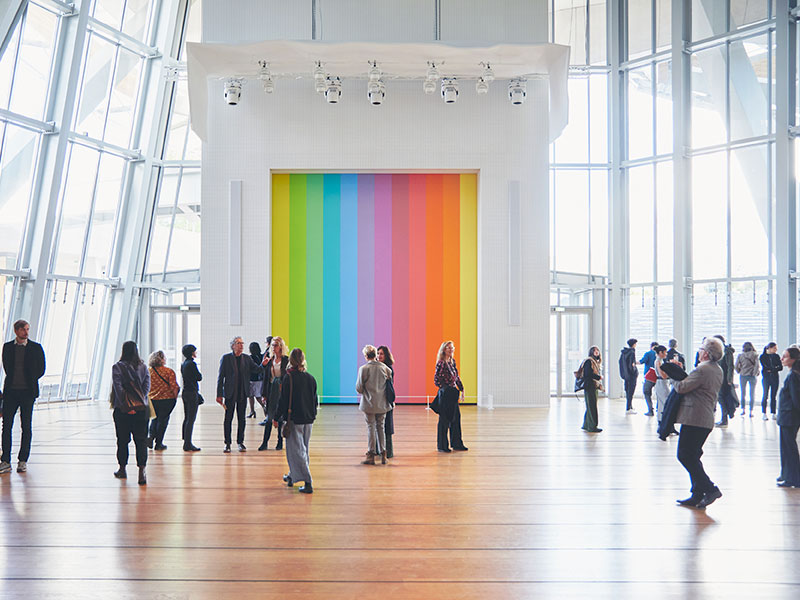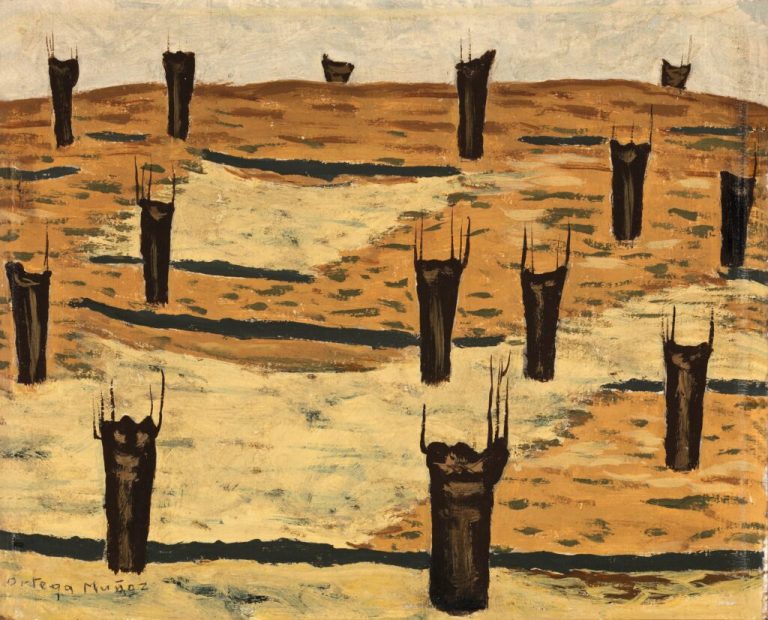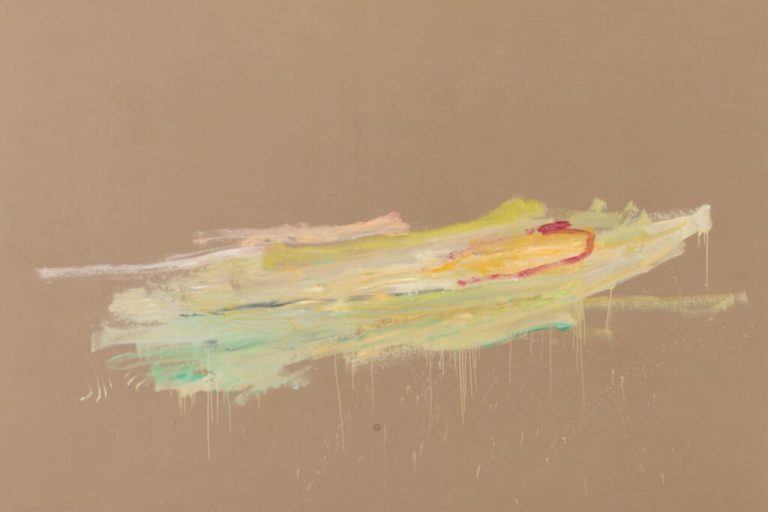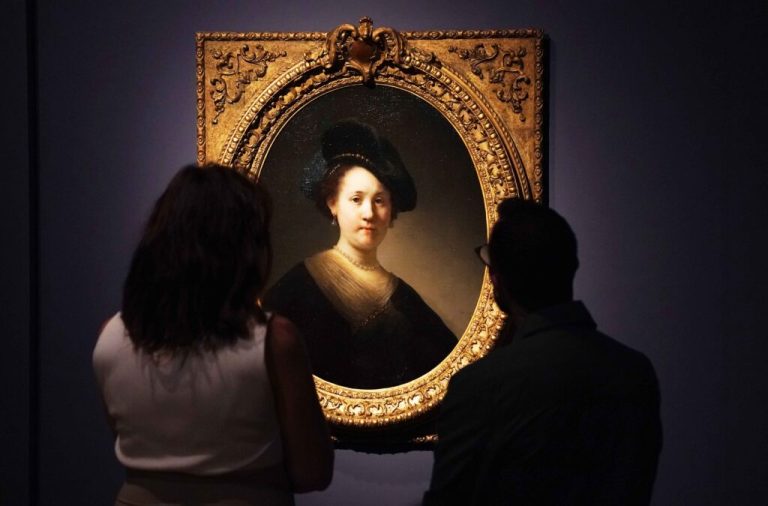Paris. Ellsworth Kelly (1923-2015) facing Henri Matisse (1869-1954)? The two exhibitions presented by the Louis Vuitton Foundation juxtapose these two artists separated by more than half a century but united by their love of color. However, Kelly has a significant advantage over Matisse: at the Foundation, he is almost at home. In 2014, just a year before his death, he created his final monumental work. Designed for the auditorium, it is a device made up of five monochrome panels of different formats scattered throughout the space, as well as a stage curtain made up of twelve panels in the colors of the rainbow. sky. Titled Spectrum VIII, this work recalls the “Spectrum” series that the artist produced in Paris in 1953. We could even speak of a tribute, because the Parisian period had a profound impact on Kelly’s artistic production. Landing in Normandy during the war, he spent a brief period in the French capital in 1944. But it was in 1948, after taking courses at the Museum of Fine Arts in Boston (Massachusetts), that he really became installed in Paris. Benefiting from the GI Bill (a scholarship for veterans), he enrolled in Fine Arts but mainly attended the Louvre. While there, he befriended the American sculptor Alexander Calder and visited the studios of Brancusi and Hans Arp. It is probably from this period that his admiration for Matisse and Monet dates. His visit to Giverny and his contemplation of Water lilies inspired this magnificent canvas where green and blue seem to form a floating curtain (Green board1952).
Clean lines, vibrant colors
Work on color but also work on line. Starting with drawings of simple objects such as bridges, road signs and windows, he began to “to distil the forms, to reduce the depth. Moving from the third to the second dimension, he simplified complex imagery into geometric shapes” (exhibition catalog). The window, this traditional metaphor of pictorial representation, particularly attracted his attention. In 1949, Kelly made several, the best known of which is Window, Museum of Modern Art, Paris. For this construction painted on wood and canvas, he took the structure and proportions of a window from the National Museum of Modern Art of the time, today the Palais de Tokyo. This transposition of the window to the dimensions of the object represented is part of what he calls an approach “already made” (“already done”), as opposed to ready-made Duchampian, where the object chosen by the artist is proclaimed a work of art.
On this subject, Kelly writes: “After having built Window with two canvases and a wooden frame, I realized that painting as I had known it was finished for me. In the future, works should be objects, unsigned, anonymous. Everywhere I looked, everything I saw became something to achieve; everything had to be exactly what it was, with nothing superfluous. It was a new freedom: I no longer needed to compose. The subject was there, already done, and everything was material” (Notes from 1969). However, let us note the irony – voluntary or not – of choosing, in a place which offers the eye numerous artefacts, an opening which turns its back on them and which leads the gaze outwards. Irony of fate again: it was a few months before his death that Kelly offered this painting to the Center Pompidou.
Shaped canvases
Returning to the United States in 1954, the artist settled in New York and began working in the “hard-edge” style, a term meaning a sharp boundary or hard edge. Executed in relation to architecture, keeping the memory of Matisse's cut-out gouaches, his work takes on a monumental character. The simplified structure is often limited to large irregular formats, flat areas of pure color or black and white juxtaposed with clarity, neglecting complex compositions. This rejection of expressionist tension and gestures associates Kelly with the minimalist trend, notably Frank Stella. However, in numerous paintings or reliefs such as Yellow Relief (1955) or White Curves (1978), the austere shapes, rectangular or curved, located on the same plane, are organized in such a way that “their precise limits are undone, creating an optical vibration which prevents us from concentrating on a form, from determining whether it is figure or ground” (Irving Sandler, The Triumph of American Art,ed. Carré, 1990). Between painting and sculpture, these thick panels, shaped canvas (with frames adapted to the shape represented), can be incorporated into the wall or deployed on the ground, thus questioning the limits of the painting. Kelly's success came quickly. Not only did he participate in the famous exhibition organized by MoMA “Sixteen Americans” in 1959, but in 1957 the Whitney Museum of American Art bought a work from him. Numerous exhibitions and collaborations with architects followed, such as that with Frank Gehry. Finally, two lesser-known aspects of the artist's practice can be discovered at the Foundation: photography, which captures the tiny nuances of light, and the collages, sometimes humorous, made from postcards sent by Kelly himself. even.
However, let's end with flower drawings, a theme shared by Kelly and Matisse. In both cases, the leaf, stem or vein are refined shapes, devoid of any superfluous detail, on a background free of interference effects. However, despite this formal proximity, the two groups clearly express divergent concerns. For the French painter, the weaving between the components of a design, the repetition of a curve or an arabesque, create decorative “chains” which reveal the importance given to ornamentation. The American artist's stylized plants or plant fragments also seem isolated, autonomous, derealized. All that remains of the object are the contours, an emptied form, an abstraction which filigreely retains the traces of its past.







